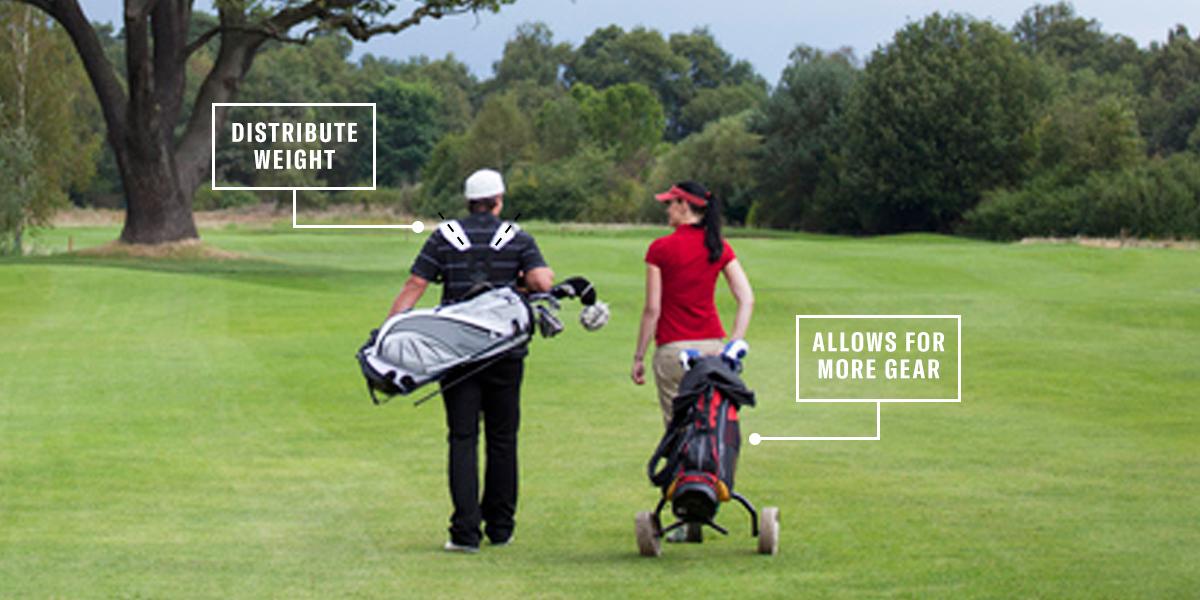Ditching the cart on the golf course increases your fitness, but it also requires fitness if you want to enjoy the day. Here’s how to build yours.

Those who do not play golf are quick to dismiss it as an “easy” sport, but walk 18 holes while carrying your golf bag and executing technically difficult shots, and you’ll quickly realize just how physically demanding the game can be. Courses range from 6,000 to 7,200 yards, so you’ll walk between 3 and 6 miles, depending on how many extra steps you take to search for wayward balls.
You’ll also torch some serious calories. Although the total will vary per person and course, a 2010 study conducted by Neil Wolkodoff, PhD, of the Colorado Center for Health and Sports Science, found that walking with a bag burned an average of 721 calories for nine holes. That’s an average of 1,442 calories burned during an 18-hole game.
Walking and carrying isn’t your only option, though. The same study also found that walking with a push cart (essentially a stroller for your golf bag) was still a solid workout, burning 718 calories per nine holes. Walking with a caddie burned 621 calories, and riding in a cart still burned 411 calories. Wolkodoff noted that the disparity was not more substantial because simply swinging the golf club requires a significant amount of energy.
If you’d like to take advantage of the extra exercise walking the golf course provides, remember that it’s a lengthy distance to cover, and golf is often played on hot, sunny days. Setting out on foot requires a baseline level of fitness if you don’t want fatigue to factor into your golf game. Here’s how to build up to walking a full 18 safely.
Step 1: Decide Whether to Carry or Push
If you’ve never walked 18 holes before, walking with a caddie who will carry your bag or using a push cart are the least physically-demanding options. While push carts can be difficult to manage if it’s particularly hilly or muddy and unwieldy around tee boxes and greens, they do allow you to easily carry extra gear. Plus, pushing is biomechanically easier than lifting and carrying.
Once you’re ready to test out carrying, remember that a set of golf clubs weighs about 15 pounds. Put them in a bag and that increases to approximately 18 pounds. Now, fill that bag with extra balls, tees, gloves, a rain jacket, a rangefinder, a cap, sunscreen, water, and snacks, and you’re looking at 25 to 30 pounds that, for the average golfer, must be picked up and put down 100 times per round. Sure, it’s doable, but it does require a certain level of fitness and mindfulness.

“Picking up a golf bag is a unique movement with a lot of internal and external rotation of the shoulder,” explains Tim Dunlavey, an athletic trainer and strength coach who works with professional golfers. “For amateur golfers who use their arms and shoulders rather than their core a lot more than elite golfers in their swings, that can add up to a lot of stress.”
To avoid an imbalance resulting from lifting the bag on one side, alternate a one-strap carry from one shoulder to the other, or use a bag with back-pack straps that distribute weight evenly on both sides and be mindful about alternating which hand you use to hoist it up after each shot. Lastly, remember to stand tall when you carry your bag; hunching forward or to one side will increase pressure on your spine.
Step 2: Build Your Base
If you haven’t so much as taken a walk all winter, it would not be wise to try to walk 18 holes on your first day back on the course. And while many don’t think of golf as “cardio,” a long day on your feet can certainly feel like a marathon, so, approach it like one.
Dunlavey suggests starting by walking a mile around your neighborhood or a hilly park, and then gradually increasing the distance. “You wouldn’t just go out and run a marathon, you’d go through the training program,” he says. “You have to do the same with golf.” If you’d rather do your training on the course, Dunlavey suggests starting with walking nine holes and picking up a cart at the turn.

Step 3: Factor in Fatigue
If you’re not conditioned to walking long distances while also swinging your golf clubs, fatigue can affect your game in ways you may not even realize. “Fatigue exposes any flaws in the golf swing,” says Dunlavey. “If you’re someone who has early extension, meaning you stand up in the swing, that will get worse as you get tired, and you’ll be unable to stay down at impact. If you’re a slicer who doesn’t finish the swing and you never get the club face closed, that flaw will also get worse with fatigue.”
Dunlavey notes that as your endurance wanes, you may also feel you need to take extra club late in your round, because your shot distance has decreased due to a decrease in force production. He also says that walking—with or without your bag— puts stress on the hamstrings and low back, and tightness in those areas will increase along with fatigue.
Off-course, endurance-based golf workouts on Tonal can prep your body to fight the fatigue that creeps in on the back nine. Try any of these options:
- Beginners can try Metabolic Strength with Coach Brandon for full-body conditioning.
- Power and Control: Driving will help you build golf-specific strength with tips from golf champion Michelle Wie West.
- Lower Body Level Up with Coach Allison builds glute and hamstring strength and endurance.
- Lean Machine Bootcamp with Coach Nicolette provides full-body push and pull workouts to help you get out of the bunkers and lift your golf bag.
Step 4: Focus on Nutrition
Watch a professional golf event on television, and you’ll see players dipping into coolers of water and electrolyte beverages on every tee box. You’ll also notice them munching on snacks as they walk up the fairways. Pro golfers generate big power with each swing, and sweat a ton walking up and down the hills. If they don’t properly re-fuel, things will start to break down.
Your nutrition and hydration should be no different. “The days of thinking of golf as an easy-walking, easy-swinging, have-a-beer-activity are behind us, if you want to perform your best,” Dunlavey says. Try stashing grab-and-go snacks that include easily-digestible carbs and some protein in your golf bag, such as energy bars, trail mix, beef jerky or cheese sticks and a piece of fruit, or a peanut butter and jelly sandwich. You’ll also notice most golfers slather on sunscreen and wear hats or visors because sunburn accelerates dehydration and fatigue.


